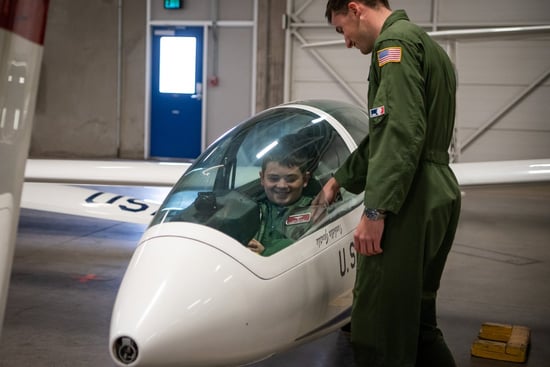Jack Schaef wants to fly as a pilot someday, but it might just be water that helps make that dream come true.
What started out as a normal day at the pool for the 11-year-old boy last summer turned into the beginning of a mysterious medical journey that resulted in a retinoblastoma diagnosis.
“He was saved by a bellyflop,” says Scott Oliver, MD, associate professor in the Department of Ophthalmology at the University of Colorado School of Medicine. When Jack dived into the pool, the impact of hitting the water ruptured a cancerous tumor inside his eye.
For weeks, it was unknown to doctors what caused Jack’s loss of vision. His mother, Dayna Schaef, thought it might have been a blood vessel that burst. Jack could also see floaters in his eye, but it was unclear why at the time.
Finally, Jack’s eye had cleared enough for Oliver’s official diagnosis – unilateral retinoblastoma, a rare form of eye cancer.
“I could not have ever expected that it was going to be a cancer diagnosis,” Schaef says.
A rare case with successful treatment
Oliver, who directs the eye cancer program and is the chief of retina services at the Sue Anschutz-Rodgers Eye Center, has treated many children with retinoblastoma, but none quite like Jack.
“Everything about Jack’s case is out of the ordinary,” Oliver recalls. “He doesn’t fit the usual age profile for children who are diagnosed with retinoblastoma, and his tumor presented in a rare way.”
Retinoblastoma occurs mostly in young children – younger than Jack – and accounts for about 2% of all childhood cancers. The cancer starts in the retina, which consists of nerve tissue that senses light. The disease affects about 200 to 300 children in the U.S. per year, according to the American Cancer Society. More than 95% of those patients are cured, but eye removal can be common in more complicated cases.
Jack and his family were presented with a treatment option that could save the vision in his affected eye: intra-arterial chemotherapy (IAC).
Doctors thread a catheter through the femoral artery, past the heart up through the carotid artery and then into the artery that feeds the eye. Chemotherapy drugs are pumped through the vessel to directly target the tumor. Only a handful of centers in the U.S. offer the full spectrum of retinoblastoma treatment, including IAC.
“This treatment has really pushed our care of this disease forward and allowed us to save most eyes, even those with advanced disease,” Oliver explains. “It’s quite an elegant technique.”
Jack received five rounds of the treatment, each time having to spend a night at the hospital to ensure no complications.
“Once we figured out the diagnosis, we moved quickly with treatment,” Oliver says. “He’s responded beautifully and now he can get back to his life.”
Oliver and his team were able to save Jack’s eye and restore excellent vision, an important factor in Jack’s dream to one day become a commercial pilot.
From the pool to the skies
Jack got a taste of what his future could be like with the Make-A-Wish Foundation by becoming a cadet for a day at the Air Force Academy in Colorado Springs.
“It was pretty much the best day of our lives,” Schaef recalls.

Jack Schaef dreams of being a pilot one day. Photo courtesy of the Schaef family.
Jack got a close-up view of military fighter jets and was able to fly a Cessna plane all by himself. The icing on the cake was having his name permanently painted onto the side of one of the academy’s training planes.
The experience reinforced Jack’s dreams. He’d like to fly giant passenger planes someday. The Boeing 757 is among his favorites. “It’s the sports car of the sky,” he says.
Jack’s dream is still alive with the help of his doctors, his mom says.
“We are completely blown away with the amazing team we got to work with,” Schaef says. “I could not be more impressed with the whole system. We consider ourselves very lucky and very blessed. We want to shout from the rooftops that this is an incredible program. Dr. Oliver is saving lives.”


.png)

